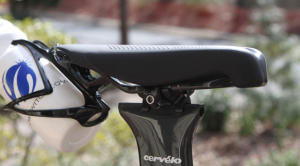For many triathletes, John Cobb is a name that provokes instant recognition. John has been around the industry for a long time, and is regarded as an expert in bike fit, aerodynamics, and saddle design. John started a company called Blackwell Research in 2004, which sold aerobars, bicycle forks, and even carbon wheels. Blackwell closed its doors in 2008, and shortly thereafter John launched his own line of saddles under the name Cobb Cycling.
I’m a big saddle geek, but until this summer I’d never tried anything from Cobb Cycling. This is our review of three models – the Plus, the SHC, and the new-for-2013 Gen2. We’ll work our way through the three different models to show you the fine details of each, including setup tips. All were ridden over the summer of 2013 on a steep seat tube (78.5 degree) tri bike.

Above photo from left to right: Gen2, Plus, and SHC.
Cobb Plus
We’ll start with what has largely become the bread and butter saddle for Cobb – the Plus. This saddle is a slightly wider and more plush version of their original V-Flow model. In fact, the original line is best described similar to Goldilocks and the Three Bears. The V-flow is the your first option. Firm, light, and racy (some might say, ‘too cold’). The big-boy Max saddle is super wide and soft (some might say, ‘too hot’). The Plus is the perfect in-between that is, as our young friend would say, ‘juuuuust right!’

Cobb has several tools on their website that are intended to help you choose the right saddle. On the Men’s Tri/TT chart below, we can see that the Plus saddle is the only one to check all of the boxes.
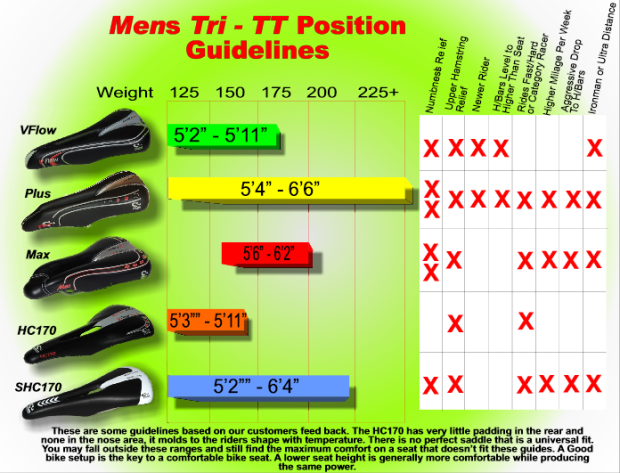
In order to install the Plus, I had to remove my existing saddle, an ISM Attack. Looking at a top-down photo, we can see that these are two very different beasts:

The main difference is obvious – width. It’s the width of the nose and width of the cutout.
Before I even put the Plus on my bike, I had questions floating around in my head about the topic of saddle girth. The biggest criticism I hear about ISM is that some people just can’t stand how wide it is in the front (resulting in chafing and/or leg interference). That has never been a problem for me personally, but I’ve heard it enough times to warrant further investigation. Is the width problem a positioning/fit issue, or something inherent in the saddle that doesn’t work for some people? If the latter, could the narrower Cobb provide all of the comfort they’re after, minus the wide front? I was eager to find out.
Let’s see how the rails compare:
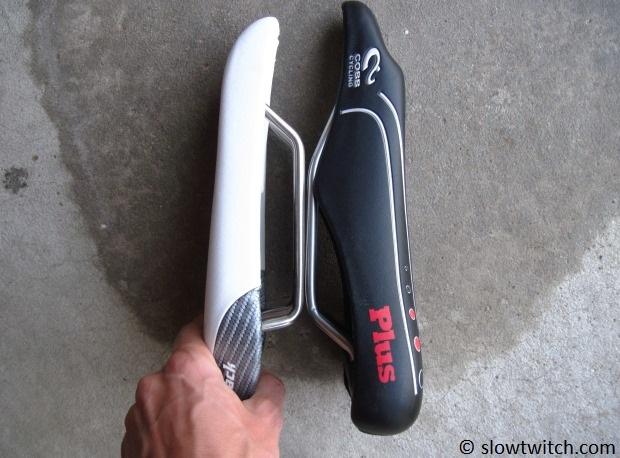
I measured the Plus rails to be approximately 2cm shorter than the Attack, or about 1cm shorter than the Prologue/Breakaway/Podium models.
With saddle rails, my biggest concern is not necessarily the overall length, but rather the positioning of the rails in relation to the width of the top. Those rails ought to be positioned in a way that they work for the largest possible percentage of riders, when placed upon bikes with appropriate seat tube angles for their riding discipline (i.e. road, triathlon, cyclocross). A triathlon saddle should have rails that best accommodate the average rider on a steep ~78 degree bike. A road saddle should have rails that best accommodate the average rider on a slack ~73 degree bike. The shape, angle, and anchoring of the rails all affect this rail-to-top relationship, and all saddles are not created equal in this regard.
My Attack was set up at an 80.5cm height and -2.5cm setback. Without adjusting the height of the post, I put the Plus on the bike, and picked an arbitrary setback of +0.5cm (nose of the saddle 5mm in front of the bottom bracket’s center). The height was now at 80.2 due to different stack height, so I raised it by 3mm to match my original 80.5.
Why such a difference in setback? Put simply, my view is that the Cobb Plus fits like a traditional road saddle. It is proportioned with a nose that is much narrower than the tail. The change in width is very gradual. If you’re switching from a similar saddle to the Cobb, setup will be a breeze. For purposes of this review, I consider the vast majority of saddles on the market to fit this ‘traditional’ shape. The other key category of saddles are what I’d call super wide and/or nose-less designs, such as the Specialized Sitero, all ISM models, and the new Fizik Tritone.
When I’ve ridden traditional-style saddles in the past, I typically have had my setback in the neighborhood of zero (in-line with the bottom bracket) to +2cm. Nose-less designs result in a very different setback; usually about 3-5 centimeters further back for a given seating position. Another way to look at it is this: Nose-less saddles leave you with about 3-5 centimeters extra saddle sticking out behind your derriere when you ride (they include that extra length to remain UCI-legal). Most riders will never actually sit on that part of the seat. The traditional-style saddles tend to leave you with a similar portion of saddle that goes unused in front of you.
With the Plus installed, I got to riding. It quickly became apparent that the saddle was both too low and too far back. I adjusted the saddle forward by another 5mm, putting it all the way to the ‘max’ line on my 78.5 degree seat tube bike:
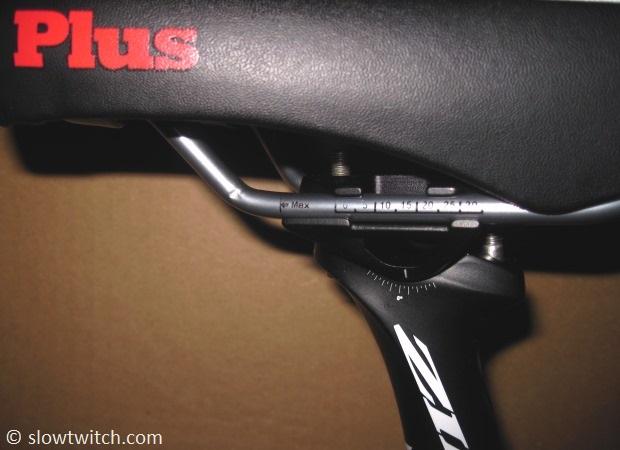
I also raised it by 5mm, to an 81cm height and +1.0cm setback. This matches my historical saddle setups to-a-T (with products like the Profile Tri Stryke and Fizik Arione Tri). My saddle height on nose-less designs is always several millimeters lower than any other saddle due to the way they ‘perch’ you on your sit bones.
With the Plus in this position, I rode… and rode… and rode some more. I made one or two tiny adjustments to the angle or the saddle (it ended up essentially level), but that’s it. My impression is that this type of saddle is THE alternative for those that dislike super-wide saddles. It stands as the most comfortable ‘traditional style’ saddle that I’ve ridden on a tri bike. The nose and cutout are just wide enough that I can sit squarely on the saddle without having to ‘pick a side’ for my more tender parts.
Note that I did notice a shift in pressure from my sit bones to soft tissue compared to my ISM. For those in search of the ‘perfect’ saddle, I give you a suggestion: define your terms clearly and have reasonable expectations. You will feel pressure somewhere. It’s a bike seat, and your weight is distributed over a smaller area than a Lay-Z-Boy. I personally have a love/hate relationship with saddles in this regard. Under very hard efforts or when climbing out-of-the-saddle, I really like narrower saddles like the Cobb Plus. There is a certain feeling of freedom and agility to it. As the distance goes up and I’m planted in my aerobars, I still prefer the very wide nose-less designs (that can sometimes feel awkward in the aforementioned scenarios).
The only thing I question about the Plus is the rail length relative to the width on the top of the saddle. With a steep seat tube angle and a zero setback seatpost, I still had to push the saddle all the way forward to get the width where I wanted it. This worked for me, but I imagine that it will not work for some rider-and-bike combinations. If it’s an older bike with a 76 degree seat tube angle, or a road bike with a forward-facing seatpost, the forward adjustment could be a limiter.
Cobb Plus Specifications:
MSRP $160
Colors: White, black, pink
130mm max width
280mm length (277mm measured)
55mm stack height (60mm measured)
Front of cutout area 45mm, back 65mm
294 grams (299 gram measured weight)
Rail fore-aft adjustment range: 64mm measured
Cobb SHC
Next up for me was the SHC. This is the saddle ridden by Cobb-sponsored Jordan Rapp, so of course I had to see what it was all about. He described it to me like this:
“I ride the SHC170, which is more of a ‘pro-style’ tri saddle - thin, firm-ish, narrow, etc. Quite popular among lighter men who put out pretty good power.”

Why did he mention power? It’s as simple as this – the more power you put out, the less weight you have on your saddle. That also means that you require less padding, and can normally use a narrower (and lighter) saddle. Looking at the Cobb TT/Tri saddle recommendation sheet, it’s clear to see who the SHC is intended for (the men’s and women’s guidelines are identical for this model):

I took the Plus saddle off, left the seatpost in the exact same position, and mounted the SHC. The height ended up 5mm lower than the Plus at 80.5cm, perfectly matching the stack height numbers published by Cobb. I raised the saddle by 5mm to get back to my 81cm mark. As you can see, I was now quite a bit higher than when I started:

With the rails set in the same ‘max forward’ position as the Plus saddle, the resulting setback was 5mm shorter, at +0.5mm.

It was hard to not notice a big detail about the saddle rail markings – there is virtually no adjustment range. I measured 2-3mm total. For reference, my seatpost is a Zipp Service Course model. Perhaps the Zipp post has a longer-than-average clamp, but I can’t see many other designs being that much shorter to make an appreciable difference. I’ve certainly seen some people adjust their saddles beyond the ‘max’ line, but I do not know of the warranty or safety implications.
I should also mention that the top of the saddle is angled very sharply in a ‘nose-down’ fashion. The angle is dramatically different than either the Plus or Gen2. I was able to correct for this with my seatpost, but the front bolt did not engage fully into the threads of the nut in the saddle clamp. Nothing came loose while riding, but I would definitely keep an eye on it if I was going to ride the saddle full-time for a year. Better yet, I’d try to find an extra long bolt.
In any case, I left the saddle where it was and got to riding. Overall, the saddle felt as I expected – similar to the Plus, but a little bit firmer. The very tip of the nose is narrower on the SHC, but the usable width (that you actually sit on) is virtually the same. Thigh clearance is generous and allows you to move around very freely while climbing or sprinting.
While I prefer the Plus to the SHC, I was pleasantly surprised at the comfort-for-weight factor of the SHC. This should come as no surprise based on Jordan’s advice, seeing as he is both lighter AND more powerful than I am. Wimps unite on our soft saddles!
If I wanted to get back into road or crit racing, this saddle would be very high on my list. Being so narrow and nicely rounded on the edges, it really stays out of your way – especially on a road bike with slack seat tube angle.
Cobb SHC Specifications:
MSRP $200
Colors: White, black, pink
130mm max width
260mm length (273mm measured)
50mm stack height (55mm measured)
Front of cutout area 40mm, back 65mm
204 grams (210 gram measured weight)
Rail fore-aft adjustment range: 51mm measured
Cobb Gen2
The Gen2 is the newest addition to the Cobb line:

In a promotional video, Cobb says that the Gen2 is primarily designed for road riders, but can also be used for triathlon. Comparing it to the Plus, we can see that the contour of the top is different, and the width starts to taper further towards the rear:

Compared to the SHC, it becomes immediately clear that the rail-to-top angle is hugely different, and the story is similar to the Plus in terms of width:
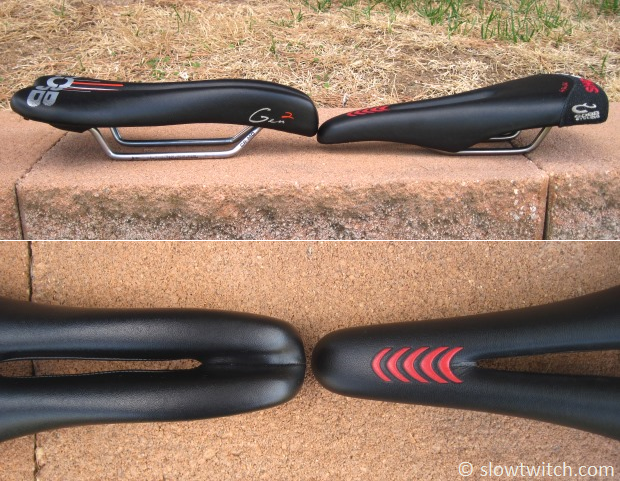
One clear improvement that Cobb made with the Gen2 is rail length. This photo shows the Gen2 vs. the Plus (left) and the Gen2 vs. the SHC (right):

One area that needs improvement, however, is the application of the rail markings. This photo shows my Gen2 when it was brand new out-of-the-box:

I installed the Gen2 immediately after the SHC. The saddle height was at a whopping 82cm, clearly illustrating the increased stack height (I quickly lowered it to my 81cm standard).
Setback also changed quite a bit. Here is the setback of all three saddles on the same bike – at the same saddle height – in the ‘max forward’ position as designated by the rail markings:
Plus: +1cm
SHC: +5mm
Gen2: -1cm
It appears that Cobb has really changed their tune with the Gen2 in terms of rail placement. To me, this rearward positioning definitely suggests that the saddle is indeed designed with road bikes as the primary target. The difference between the Gen2 and the Profile Tri Stryke is striking in terms of steep riding ability.
I rode the saddle in this configuration and could immediately tell that it was too far back. There was simply not enough saddle under me and it was not comfortable. I decided to push the saddle 1cm forward of the ‘max’ markings:
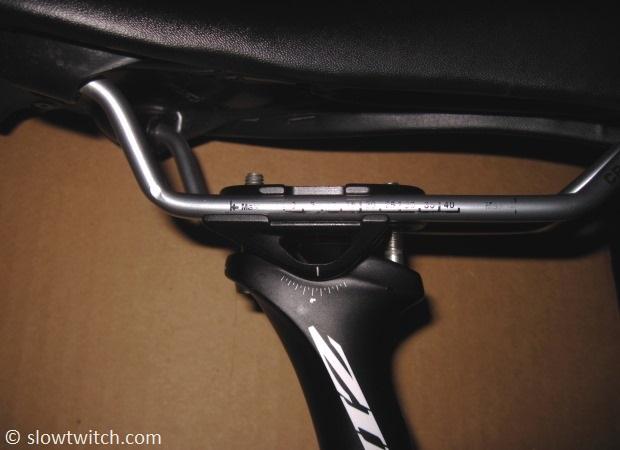
In this position, the comfort increased slightly, but I could tell within a few minutes that the saddle would not be my favorite. I played with the tilt quite a bit, but ended my one hour trainer ride knowing that the Gen2 and I were not meant to be.
The Gen2 really reminded me of the similar-shaped Selle San Marco Aspide Tri saddle that I used about ten years ago. It’s long, it’s narrow (relative to the super-wide options today), and the width doesn’t increase until you get well to the rear of the saddle. While the top of the saddle feels relatively cushioned in your hand, the lack of width made it feel hard (to me) while sitting in the aero position, regardless of the saddle angle.
Cobb Gen2 Specifications:
MSRP $200
Colors: White, black
130mm max width
270mm length (274mm measured)
63mm stack height
48mm cutout area
295 grams (296 gram measured weight)
Rail fore-aft adjustment range: 73mm measured
Wrap Up
I think Cobb stands as a great choice for those who want a cutout tri saddle, without being super wide. For someone like me that does prefer wider saddles, the best option is likely the Max, which I have yet to try. It should go without saying - regardless of what a review says - saddles are something that you need to try for yourself with the guidance of a skilled bike fitter. Events like the Slowtwitch Saddle Tour allow you to try as many saddles as you want in a very short amount of time, for free. The first decision in buying tri saddles should be a simple one: Do you like a ‘normal’ saddle or a wide nose-less type saddle? Once you’ve established that, you can start to pick apart the minute details between models.
The key thing I’d like to see Cobb change is a to have longer rails, and more consistent setup features between models (rail length, placement, and angle, stack height, etc). It seems to me that they’re accommodating slacker effective seat tube angles, or rather that your bike must have a very steep seat tube angle in order to ride steep upon a Cobb.



